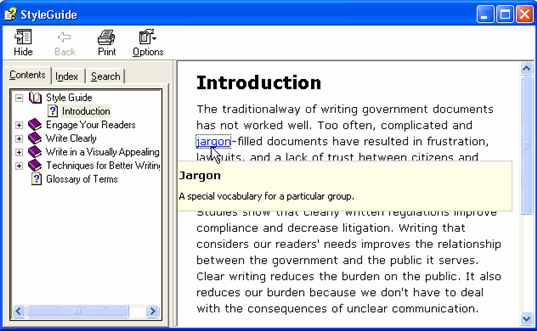Once you open the glossary document, you can begin adding and formatting glossary entries. Add the first glossary heading on the first line following the Glossary of Terms heading, and add its definition on the second line.
You may choose to format some or all glossary headings with the Glossary Heading paragraph style, which has the AutoGlossaryLinks property set to True. Note that the two sample glossary headings automatically created in the glossary document are formatted with this style. In this case, when you build a Help file, Doc-To-Help examines the project documents for text that matches the glossary headings, converting these matches into hyperlinks. If there are multiple instances in a topic where the text matches a glossary heading, Doc-To-Help creates the pop-up link at the first instance of the text.
Note: The pop-up link can be created at an instance other than the first by using the D2HNoGloss character style. See Filtering Topics from the Glossary for more information.
Whenever the user clicks one of the hyperlinks, a DHTML pop-up opens containing the corresponding glossary entry definition.
If you do not want to use this functionality for some or all terms, you can format your glossary headings with the Glossary Heading (no auto links) paragraph style in the glossary document. The glossary still appears in your Help file, but text matching the glossary headings in the source documents will not automaticllay become hyperlinks when the Help is compiled. You can create glossary links manually using D2HML in those instances where you want to link a word or phrase to a glossary term.
If you create your own glossary heading style and do not want to use the automatic glossary link functionality, set its AutoGlossaryLinks property to False.
Note: If one of the predefined glossary heading styles cannot be used, you can create your own glossary heading paragraph style. Set its TopicType property to Glossary Term Definition, which has the AutoGlossaryLinks property set to True by default, to use the automatic glossary link functionality. Set the AutoGlossaryLinks property to False if you do not want to use the automatic glossary link functionality. See Using Styles in Doc-To-Help for more information on creating paragraph styles and using Topic Types.
The glossary definitions are formatted with the C1H Popup Topic Text style. This creates the DHTML pop-up that opens when the glossary link is clicked.
To add and format a glossary entry:
1. Open the glossary document.
2. Enter the glossary heading on the first line following the Glossary of Terms heading.
3. Format this heading with the Glossary Heading paragraph style if you want Doc-To-Help to automatically create pop-up links in your source documents for text that matches the glossary heading. Use the Glossary Heading (no auto links) paragraph style if you do not want the links created automatically, and then you can format text with a D2HML hot spot to create glossary links manually.
4. Enter the glossary definition on the second line and format it with the C1H Popup Topic Text style. The entries should look like the following example.

5. After you have finished adding and formatting your glossary entries, save and close the Glossary document.
6. Make sure that the value of the Glossary property, located under Project Settings, is set to your Glossary document.
7. Select the Build menu and click Rebuild Target. It is important to rebuild the entire target to ensure that recent changes will be included. After the target is compiled, click the View Target button. If you used the Glossary Heading paragraph style, wherever the Help text matches your glossary entries (Glossary Heading), Doc-To-Help has formatted the text as a Dynamic HTML pop-up. If you used the Glossary Heading (no auto links) paragraph style, hyperlinks were not automatically created for the matching text. If you manually created glossary links using a D2HML hot spot, a DHTML pop-up appears when you click them.
